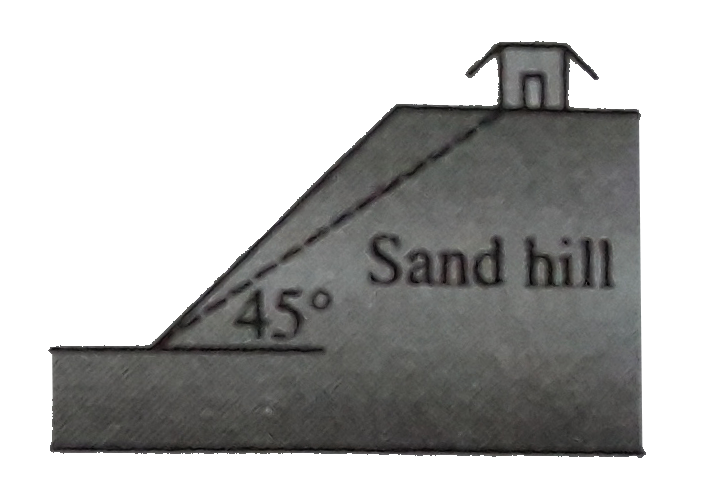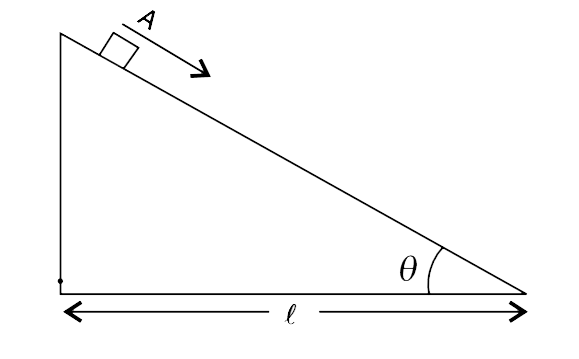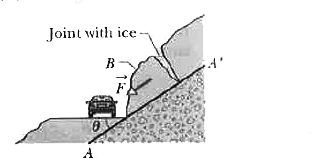A house is built on the top of a hill with 45∘slope Due to the sliding of meterial and sand top from top to the bottom of till , the slip angle has been redaced if the coefficient of static friction between sand particles is 0.75 what is the final angle attated by bill ? (tan−10.75=37∘)

8∘
45∘
37∘
30∘
The correct Answer is:c
As sand particles are sliding down , the slope of the hill gets radaced The sand particle slope coming down when component of gravity force along the hill is balanced by limiting friction force
mgsinθ=μsmgcosθ
⇒θ=tan−1(μs)=37∘
where θ is the new slope angle of half.
Topper's Solved these Questions
- BOOK - CENGAGE PHYSICSCHAPTER - NEWTON'S LAWS OF MOTION 2EXERCISE - Multiple Correct2videos
NEWTON'S LAWS OF MOTION 2
- BOOK - CENGAGE PHYSICSCHAPTER - NEWTON'S LAWS OF MOTION 2EXERCISE - Linked Comprehension52videos
NEWTON'S LAWS OF MOTION 2
- BOOK - CENGAGE PHYSICSCHAPTER - NEWTON'S LAWS OF MOTION 2EXERCISE - Subjective21videos
NEWTON'S LAWS OF MOTION 2
- BOOK - CENGAGE PHYSICSCHAPTER - NEWTON'S LAWS OF MOTION 1EXERCISE - Integer5videos
NEWTON'S LAWS OF MOTION 1
- BOOK - CENGAGE PHYSICSCHAPTER - PROPERTIES OF SOLIDS AND FLUIDSEXERCISE - INTEGER_TYPE2videos
PROPERTIES OF SOLIDS AND FLUIDS
Similar Questions
A small body A starts sliding down from the top of a wedge (see fig) whose base is equal to l. The coefficient of friction between the body and wedge surface is μ=1.0. At what value of angle q will the time of sliding be least?
 View Solution
View SolutionAn insect is at the bottom of a hemispherical ditch of radius 1 m. It crawls up the ditch but starts slipping after it is at height h from the bottom . If the coefficient of friction between the ground and the insect is 0.75 , then h is : (g=10ms−2)
View Solution
Knowledge Check
- Question 1 - Select One
What is the time required for a block to slide down from the top to the bottom ofan inclined plane 6.4 m long if the inclination of the plane with the horizonta l is 30° and the coefficient of friction= 0.2?
A2sB1.5sC3sD2.5s - Question 2 - Select One
You are to conduct a series of trials. For each trial the inclination of the plane is set to an angle theta, ranging from 0∘→90∘ and an object is released from rest at the top of the stationary inclined plane. The coefficient of static friction between the object and the inclined plane is μs. In each case below, predict the observed outcome for the trial. In the following equation 'tumble' means 'tip' over and rotate' and 'sliding' means NO tumbling Case1: The object is a sphere and μs=0
 AThe sphere will roll without slipping for small θ and slide down only for θ greater than a certain non-zero valueBThe sphere will remain at rest for small θ and roll without slipping only for θ greater than a certain non-zero valueCThe sphere will slide down for all θ>0∘DThe Sphere will roll without slipping for all θ>0∘
AThe sphere will roll without slipping for small θ and slide down only for θ greater than a certain non-zero valueBThe sphere will remain at rest for small θ and roll without slipping only for θ greater than a certain non-zero valueCThe sphere will slide down for all θ>0∘DThe Sphere will roll without slipping for all θ>0∘ - Question 3 - Select One
You are to conduct a series of trials. For each trial the inclination of the plane is set to an angle theta, ranging from 0∘→90∘ and an object is released from rest at the top of the stationary inclined plane. The coefficient of static friction between the object and the inclined plane is μs. In each case below, predict the observed outcome for the trial. In the following equation 'tumble' means 'tip' over and rotate' and 'sliding' means NO tumbling Case3 : The object is a cube and mu_(s) is very large (μ>>1)
Athe cube will remain at rest for small theta and slide down only for theta greater than a certain non-zero valueBThe cube will stay on the incline as if it were glued to it, for all θCThe cube will move relative to the inclined plane only for θ=90∘DThe cube will tumble down only for θ>45∘
A crate, in the form of a cube with edge lengths of 1.2 m, contains a piece of machinery, the center of mass of the crate and its contents is located 0.30 m above the crate's geometrical center. The crate rests on a ramp that makes an angle θ with the horizontal. As θ is increased from zero, an angle will be reached at which the crate will either tip over or start to slide down the ramp. If the coefficient of static friction between ramp and crate is 0.30, (a) does the crate tip or slide and (b) at what angle θ does this occur? If μs=0.70, (c) does the crate tip or slide and (d) at what angle θ does this occur? (Hint: At the onset of tipping, where is the normal force located?)
View SolutionFigure 6-36 shows the cross section of a road cut Joint with ice into the side of a mountain. The solid line AA' represents a weak bedding plane along which sliding is possible. Block B directly above the highway is separated from uphill rock by a large crack (called a joint), so that only friction between the block and the bedding plane prevents sliding. The mass of the block is 1.5×107kg, the dip angle θ of the bedding plane is 24∘, and the coefficient of static friction between block and plane is 0.63. (a) Show that the block will not slide under these circumstances. (b) Next, water seeps into the joint and expands upon freezing, exerting on the block a force F parallel to AA'. What minimum value of force magnitude →F will trigger a slide down the plane?
 View Solution
View SolutionA block lies on a wedge with the slope angle α. The coefficient of static friction between the bar and the wedge is μ<tanα. What should be the acceleration of the wedge to prevent the bar from sliding down?
View SolutionA block is gently placed at the top of an inclined plane 6.4 m long . Find the time taken by the block to slide down to the bottom of the plane . The plane makes an angle30∘ with the horizontal Coefficient of friction between the block and the plane is 0.2 Take g=10m/s2 .
View SolutionA book sits on a horizontal top of a car which accelerates horizontally from rest. If the static coefficient of friction between car top and book is 0.45, what is the maximum acceleration the car can have if the book does not slip ? (g=10ms−2)
View Solution

